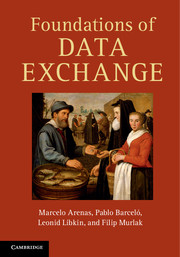Book contents
- Frontmatter
- Dedication
- Contents
- Preface
- Part One GETTING STARTED
- Part Two RELATIONAL DATA EXCHANGE
- Part Three XML DATA EXCHANGE
- Part Four METADATA MANAGEMENT
- 17 What is metadata management?
- 18 Consistency of schema mappings
- 19 Mapping composition
- 20 Inverting schema mappings
- 21 Structural characterizations of schema mapping
- 22 Endnotes to Part Four
- References
- Index
21 - Structural characterizations of schema mapping
from Part Four - METADATA MANAGEMENT
Published online by Cambridge University Press: 05 June 2014
- Frontmatter
- Dedication
- Contents
- Preface
- Part One GETTING STARTED
- Part Two RELATIONAL DATA EXCHANGE
- Part Three XML DATA EXCHANGE
- Part Four METADATA MANAGEMENT
- 17 What is metadata management?
- 18 Consistency of schema mappings
- 19 Mapping composition
- 20 Inverting schema mappings
- 21 Structural characterizations of schema mapping
- 22 Endnotes to Part Four
- References
- Index
Summary
Mappings are logical specifications of the relationship between schemas. In data exchange, one typically restricts the kind of dependencies allowed in mappings, either to be able to find more efficient procedures for constructing solutions and answering target queries, or to make mappings have desirable properties, such as closure under composition. These two tasks could be contradictory. For instance, the mapping language of SO tgds ensures closure under composition, but such mappings include a form of second-order quantification that can be difficult to handle in practice. Thus, it is desirable to replace an SO tgd by an equivalent set of st-tgds whenever possible.
In this chapter, we consider the problem of simplifying schema mappings by providing characterizations of the most common classes of mappings in terms of the structural properties they satisfy. The main goal for studying these properties is to isolate the features that different classes of mappings satisfy, and to understand what one can lose or gain by switching from one class of mappings to another. We present basic structural properties and then we use them to characterize the class of mappings specified by st-tgds, both generally, and in LAV and GAV scenarios. We also show that the structural characterizations can be used to derive complexity-theoretical results for testing definability of a mapping into some class of mappings.
Information
- Type
- Chapter
- Information
- Foundations of Data Exchange , pp. 300 - 311Publisher: Cambridge University PressPrint publication year: 2014
